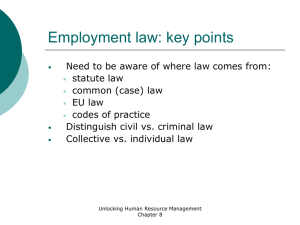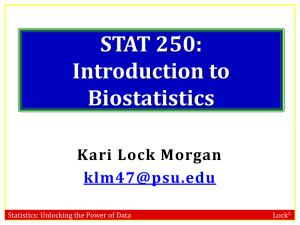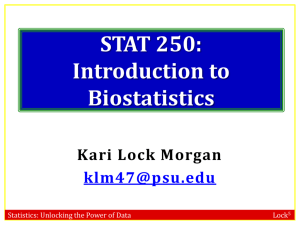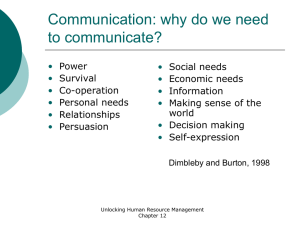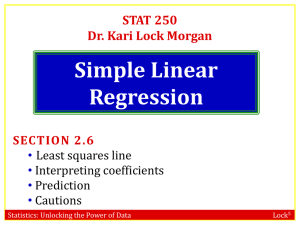Sec9-1 - Personal.psu.edu
advertisement
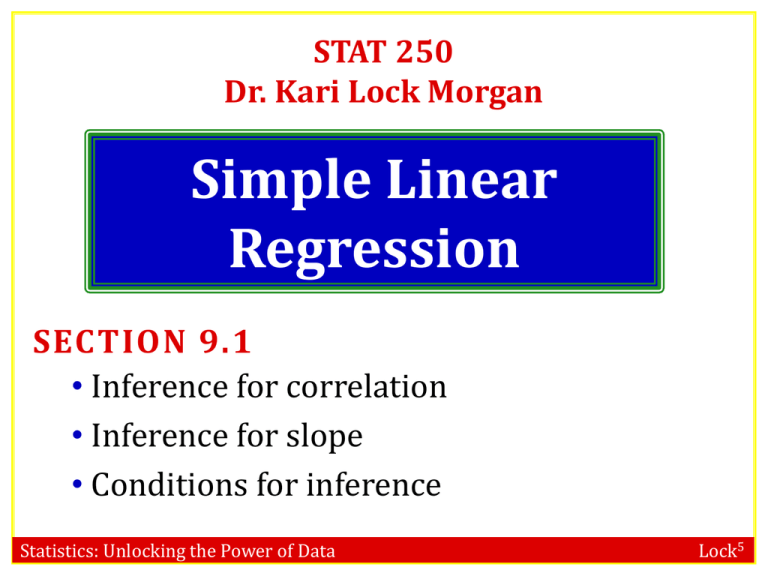
STAT 250 Dr. Kari Lock Morgan Simple Linear Regression SECTION 9.1 • Inference for correlation • Inference for slope • Conditions for inference Statistics: Unlocking the Power of Data Lock5 Social Networks and the Brain Is the size of certain regions of your brain correlated with the size of your social network? Data from 40 students at City College London How to measure brain size? How to measure social network size? Source: R. Kanai, B. Bahrami, R. Roylance and G. Ree (2011). Online social network size is reflected in human brain structure, Proceedings of the Royal Society B: Biological Sciences. 10/19/11. Statistics: Unlocking the Power of Data Lock5 Measuring Brain Size Structural Magnetic Resonance Imaging (MRI) Voxel-based morphometry (VBM) to compute regional grey matter volume based on T1-weighted anatomical MRI scans Brain regions found significant in initial study Amygdala (emotion and emotional memory) Middle temporal gyrus (social perception) Entorhinal cortex (memory and navigation) Superior temporal sulcus (perception of others) Response: normalized z-score of grey matter density for these brain regions Statistics: Unlocking the Power of Data Lock5 Brain Regions Image from Do our Brains Determine our Facebook Friend Count? (www.nature.com) Statistics: Unlocking the Power of Data Lock5 Social Networks and the Brain How to measure size of social network? How many were present at your 18th or 21st birthday party? If you were going to have a party now, how many people would you invite? What is the total number of friends in your phonebook? Write down the names of the people to whom you would send a text message marking a celebratory event. How many people is that? Write down the names of people in your phonebook you would meet for a chat in a small group (one to three people). How many people is that? How many friends have you kept from school and university whom you could have a friendly conversation with now? Explanatory variable How many friends do you have on ‘Facebook’? How many friends do you have from outside school or university? Write down the names of the people of whom you feel you could ask a favor and expect to have it granted. How many people is that? Statistics: Unlocking the Power of Data Lock5 Social Networks and the Brain r = 0.436 Is the association significant? Statistics: Unlocking the Power of Data Lock5 Standard Error Formulas Parameter Distribution Proportion Difference in Proportions Mean Difference in Means Correlation Standard Error Normal p(1 p) n Normal p1 (1 p1 ) p2 (1 p2 ) n1 n2 2 t, df = n – 1 t, df = min(n1, n2) – 1 t, df = n – 2 Statistics: Unlocking the Power of Data n 12 n1 22 n2 1- r 2 n-2 Lock5 Social Networks and the Brain • Is the grey matter volume of these regions of the brain significantly correlated with number of Facebook friends? • From n = 40 people, we find r = .436. Is this significant? (a) Yes (b) No Statistics: Unlocking the Power of Data Lock5 Social Networks and the Brain 1. State hypotheses: 2. Check conditions: 3. Calculate test statistic: 4. Compute p-value: 5. Interpret in context: Statistics: Unlocking the Power of Data Lock5 Social Networks and the Brain Should you go out and add more Facebook friends to increase the size of your brain? a) Yes b) No Statistics: Unlocking the Power of Data Lock5 Limitations Statistics: Unlocking the Power of Data Lock5 Social Networks and the Brain Give a 95% confidence interval for ρ, the true correlation between grey matter volume in the left middle temporal gyrus and number of Facebook friends. (Can use t* = 2). a) b) c) d) (0.34, 0.54) (0.24, 0.64) (0.14, 0.73) (0.04, 0.83) Statistics: Unlocking the Power of Data r = 0.436 1- 0.436 2 SE = = 0.156 40 - 2 Lock5 R2 R2 is the proportion of the variability in the response variable, Y, that is explained by the explanatory variable, X For simple linear regression, R2 = r2 (R2 is just the sample correlation squared) Statistics: Unlocking the Power of Data Lock5 2 R R 2 0.67 R 2 0.09 How much does the variability in Y decrease if you know X? Statistics: Unlocking the Power of Data Lock5 Regression in Minitab Stat -> Regression -> Fitted Line Plot 0.4362 = 0.19 Statistics: Unlocking the Power of Data Lock5 Sample to Population Everything we have done so far is based solely on sample data Now, we will extend from the sample to the population Statistical inference! Statistics: Unlocking the Power of Data Lock5 Simple Linear Model • The population/true simple linear model is 𝑦 = 𝛽0 + 𝛽1 𝑥 + 𝜀 Intercept Slope Random error • 0 and 1, are unknown parameters • Can use familiar inference methods! Statistics: Unlocking the Power of Data Lock5 Inference for the Slope Test for whether the slope is significantly different from 0 (whether there is any linear relationship between x and y): H0 : b1 = 0 H a : b1 ¹ 0 Confidence interval for the true slope Statistics: Unlocking the Power of Data Lock5 Inference for the Slope • Confidence intervals and hypothesis tests for the slope can be done using the familiar formulas: sample statistic t SE * sample statistic null value t SE • Population Parameter: 1, Sample Statistic: 𝛽1 • Use t-distribution with n – 2 degrees of freedom Statistics: Unlocking the Power of Data Lock5 Regression in Minitab Stat -> Regression -> Regression -> Fit Regression Model Statistics: Unlocking the Power of Data Lock5 Inference for Slope n = 40 Is the slope significantly different from 0? (a) Yes (b) No Give a 95% confidence interval for the true slope. Statistics: Unlocking the Power of Data Lock5 Hypothesis Test Statistics: Unlocking the Power of Data Lock5 Regression in Minitab Stat -> Regression -> Regression -> Fit Regression Model Statistics: Unlocking the Power of Data Lock5 Two Quantitative Variables • The t-statistic (and p-value) for a test for a non-zero slope and a test for a non-zero correlation are identical! • They are equivalent ways of testing for a linear association between two quantitative variables. Statistics: Unlocking the Power of Data Lock5 Confidence Interval statistic t * SE 0.0023 ± 2 ´ 0.00077 (0.00076,0.00384 ) We are 95% confident that the true slope, regressing grey matter volume of the left temporal gyrus on number of Facebook friends, is between 0.00076 and 0.00384. Statistics: Unlocking the Power of Data Lock5 Multiple Testing? Statistics: Unlocking the Power of Data Lock5 False Positive (Type I Error) Protection To further protect against Type I errors, they performed two independent analysis on two separate samples (n = 125, then n = 40) Statistics: Unlocking the Power of Data Lock5 Real-World Network Size What about real-world network size? Statistics: Unlocking the Power of Data Lock5 Conditions Inference based on the simple linear model is only valid if the following conditions hold: 1) Linearity 2) Constant Variability of Residuals 3) Normality of Residuals Statistics: Unlocking the Power of Data Lock5 Linearity • The relationship between x and y is linear (it makes sense to draw a line through the scatterplot) Statistics: Unlocking the Power of Data Lock5 Dog Years Charlie • From www.dogyears.com: “The old rule-of-thumb that one dog year equals seven years of a human life is not accurate. The ratio is higher with youth and decreases a bit as the dog ages.” • 1 dog year = 7 human years • Linear: human age = 7×dog age ACTUAL LINEAR A linear model can still be useful, even if it doesn’t perfectly fit the data. Statistics: Unlocking the Power of Data Lock5 “All models are wrong, but some are useful” -George Box Statistics: Unlocking the Power of Data Lock5 Residuals (errors) Conditions for residuals: i ~ N 0, The errors are normally distributed Check with a histogram The average of the errors is 0 (Always true for least squares regression) Statistics: Unlocking the Power of Data The standard deviation of the errors is constant for all cases Constant spread of points around the line Lock5 Regression in Minitab Is the association approximately linear? a) Yes b) No Is the spread of the points around the line approximately constant? a) Yes b) No Statistics: Unlocking the Power of Data Lock5 Histogram of Residuals Are the residuals approximately normally distributed? a) Yes b) No Statistics: Unlocking the Power of Data Lock5 Non-Constant Variability Statistics: Unlocking the Power of Data Lock5 Non-Normal Residuals Statistics: Unlocking the Power of Data Lock5 Conditions not Met? • If the association isn’t linear: don’t use simple linear regression • If variability is not constant, or residuals are not normal: The model itself is still valid, but inference may not be accurate • If you want to do something more fancy so the conditions are met… take STAT 462! Statistics: Unlocking the Power of Data Lock5 Simple Linear Regression 1) Plot your data! • • • Association approximately linear? Outliers? Constant variability? 2) Fit the model (least squares) 3) Use the model • • Interpret coefficients Make predictions 4) Look at histogram of residuals (normal?) 5) Inference (extend to population) • Inference on slope (interval and test) Statistics: Unlocking the Power of Data Lock5 To Do Read Section 9.1 Do HW 9.1 (due Friday, 3/24) Study for Exam 3 (Friday, 3/24) Statistics: Unlocking the Power of Data Lock5


